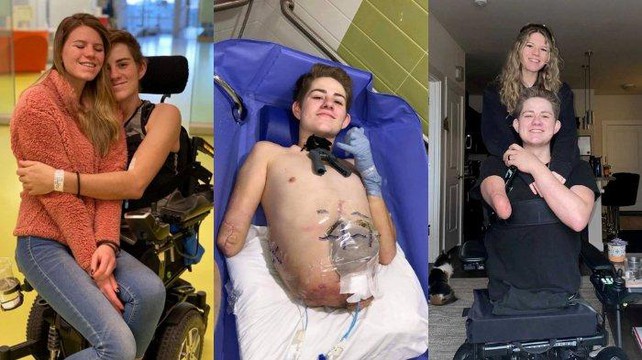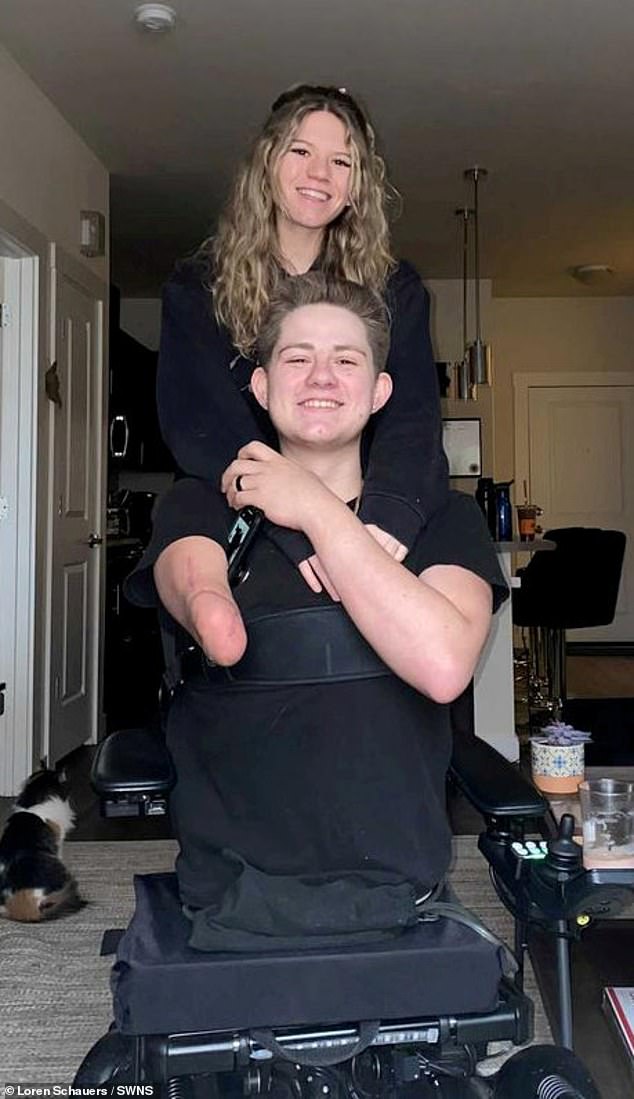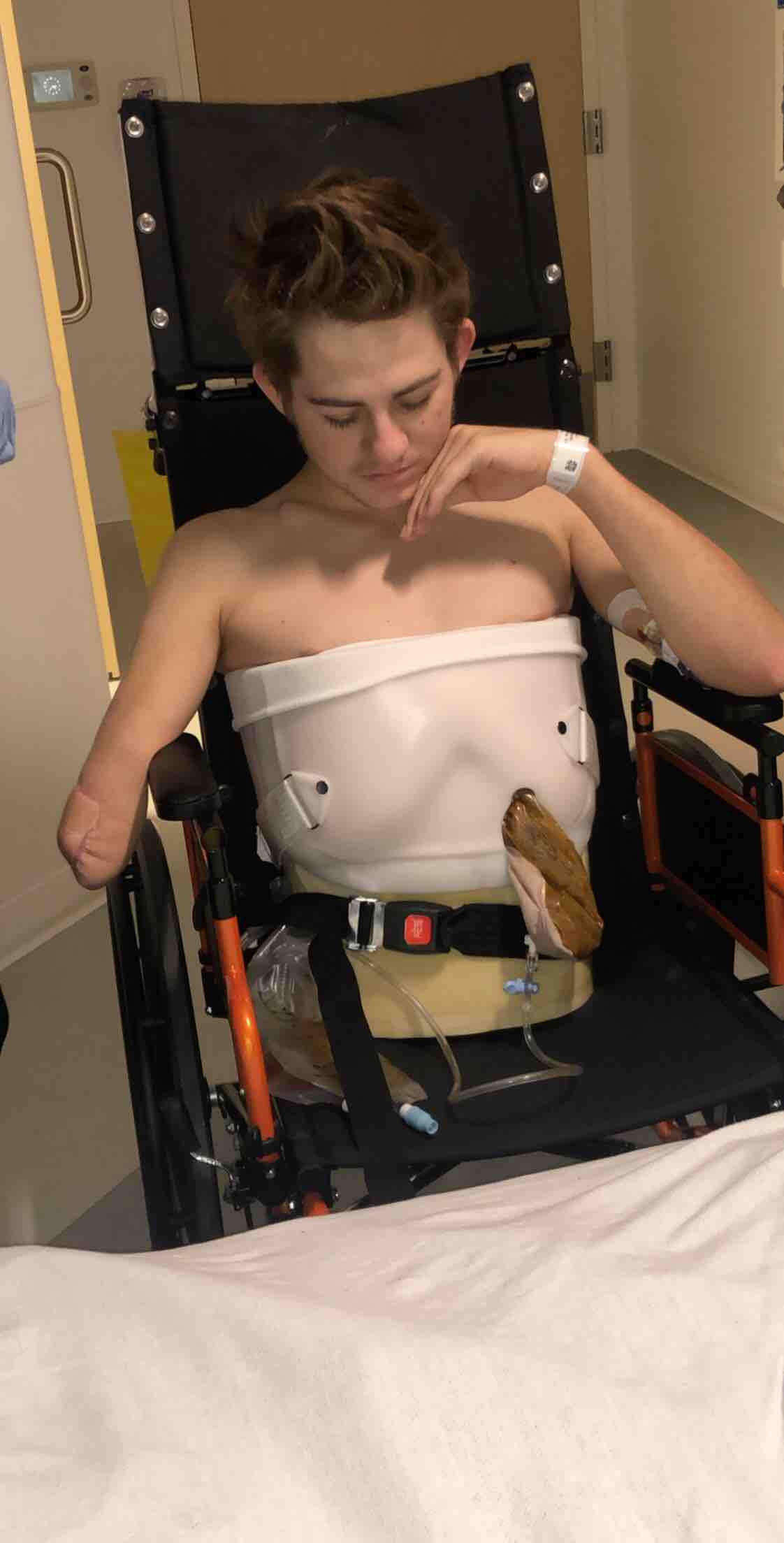In 2019, a tragedy changed the life of a young man named Loren Schauers forever. He was only 19 — full of energy, working outdoors, and dreaming of a simple future: a steady job, a home, and a life with his girlfriend,
Sabia.
But one single moment would erase all of that and turn Loren into a living symbol of human resilience — a reminder of what it truly means to choose life, even when everything else is taken away.

The Day Everything Changed
It was a normal workday in Montana. Loren was operating a forklift, moving heavy materials across a temporary bridge. He had done this countless times before. The bridge, though narrow, seemed stable.
But as he drove across, the unthinkable happened — the ground beneath the vehicle gave way. The forklift tilted, then plunged 50 feet down a steep embankment.

Loren had no time to react. The massive machine crushed his body as it fell, pinning him beneath tons of steel. When coworkers rushed to help, what they found was almost impossible to look at.
Loren was conscious — awake, speaking, even — but his lower body had been completely mangled. His pelvis, legs, and lower abdomen were crushed beyond repair.
When the paramedics arrived, they said later that they had never seen anyone survive such trauma. Most people wouldn’t have lasted a few minutes. But somehow, Loren was still fighting.
He kept repeating one thing:
“Please… don’t let me die.”
A Decision Between Life and Death
At the hospital, doctors faced an unimaginable decision. Loren’s injuries were so severe that no conventional surgery could save him. His lower body was gone — blood flow cut off, organs destroyed.
The only possible option was an extremely rare and radical procedure: a hemicorporectomy — the amputation of the body below the waist, including both legs, the pelvis, and parts of the lower spine. His right arm, crushed in the fall, also had to be removed.
Few people in history have ever survived such a surgery. The odds of living through it were near zero.
But Loren made the choice himself. He looked at the surgeons and said:
“If there’s any chance I can live, even half a life — I’ll take it.”
It was not an easy decision. For the doctors, for his family, and especially for Sabia. She held his hand, knowing that even if he survived, nothing would ever be the same.
The surgery lasted many hours. Every minute was a battle. At one point, Loren’s heart nearly stopped. But somehow, against all odds, he made it through.

Waking Up a Different Man
When Loren opened his eyes days later, he felt disoriented. He tried to move his legs — but there were none. He looked down and saw only bandages, tubes, and machines keeping him alive.
He broke down.
There are no words for that kind of loss — not just of a body, but of identity, of everything you once took for granted.
Sabia was there. She didn’t flinch. She sat beside him, held his hand, and whispered:
“You’re still you, Loren. You’re still the man I love.”
In that moment, something changed. The fear didn’t vanish, but it began to make space for something else — determination.

The Painful Road to Recovery
The months that followed were brutal. Loren spent weeks in intensive care, enduring countless smaller surgeries to prevent infection, rebuild tissue, and manage pain.
Because most of his intestines had been damaged, doctors performed an experimental
faecal microbiota transplant — a fecal transplant — to restore healthy bacteria in his gut. It was a rare and delicate procedure, but it worked. Slowly, his digestive system began functioning again.

There were nights he screamed from the pain. His body would seize up, his nerves misfiring in what doctors call “phantom pain” — sensations from limbs that no longer exist.
But through it all, Sabia was there.
She slept in the hospital room. She wiped his forehead when he sweat, fed him, talked to him about the world outside. She reminded him of what it meant to live.
“You don’t realize how strong you are,” she told him once, “until you have no choice.”
And Loren didn’t have a choice — except to fight.
The Half Man Full of Life
When Loren was finally discharged, his story began spreading around the world. Photos of him smiling — sitting upright, with only half a body — went viral.
People called him “The Half Man, Full of Life.”
Instead of hiding, Loren shared everything openly. On social media, he documented his rehabilitation, his emotional struggles, and his victories — from learning to balance on a custom-made seat to managing basic tasks by himself.
He wasn’t doing it for attention. He was doing it because he wanted others to see that life, even in the most extreme form, is still worth living.
He said in one of his videos:
“People stare at me like I’m broken. But I’m not. I’m alive. And that’s more than I ever thought I’d be.”
A Love That Defied the Odds
The love between Loren and Sabia became one of the most moving parts of his story. When others doubted she would stay, Sabia never left.
She became his full-time caregiver, but she never saw it as a burden.
“I love him,” she said. “Not his body, but his soul.”
Together, they learned to live differently. Loren’s custom chair allowed him to move independently. He could use one hand to type, play video games, or film YouTube videos.
They laughed together. They fought sometimes, like any couple. But every challenge only made them stronger.
In 2022, three years after the accident, Loren and Sabia exchanged vows in a small private ceremony. Their love story — built on pain, loyalty, and resilience — captured hearts across the globe.
Living, Not Just Surviving
Today, Loren continues to live with unimaginable physical limitations. Every movement is an effort. Infections and nerve pain are constant risks. But his spirit is unshakable.
He runs a YouTube channel with Sabia, sharing honest glimpses into their daily life — the good days and the hard ones. They also use their platform to raise awareness and funds for others living with severe disabilities.

“My body’s half gone,” Loren says, “but my heart’s still whole.”
He knows he’ll never walk again, but that doesn’t stop him from dreaming. He talks about maybe designing adaptive tools for amputees, about giving motivational talks, and about making people smile.
Because for Loren, living isn’t about what you’ve lost. It’s about what you do with what’s left.

The Symbol of Resilience
Loren Schauers’ story is not just about tragedy — it’s about transformation. From the brink of death, he chose to live. From pain, he built purpose.
In a world obsessed with perfection, Loren reminds us that humanity’s beauty lies in imperfection — in the ability to endure, to adapt, and to love despite everything.
He has inspired countless people who suffer from chronic illness, paralysis, or mental health struggles. His message is simple but powerful:
“You can lose half your body and still live a full life.”
A Life Reimagined
Each morning, Loren wakes up, straps himself into his chair, and starts another day — a day that wasn’t promised to him. He looks at Sabia, at the sun outside, and feels thankful.
He says he no longer dreams of the life he lost. He dreams of what he can still build.
He once said in an interview:
“The accident didn’t take my life — it just gave me a new one. And I plan to live it the best I can.”
That’s Loren Schauers.
The man who lost everything — and found something far greater.
“I lost half my body, but I gained a new reason to live.” – Loren Schauers
His story continues, not as a tragedy, but as a testament — that even when life breaks you in half, you can still choose to live whole.







